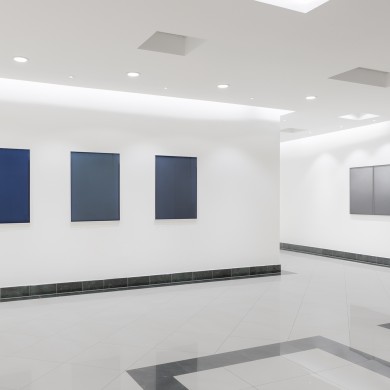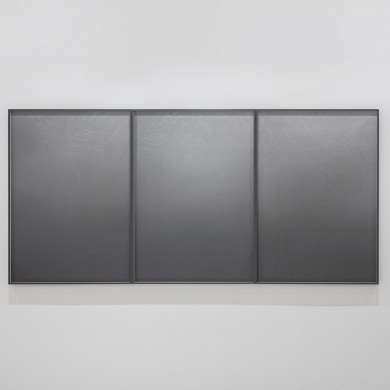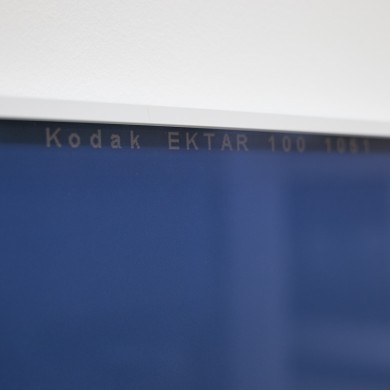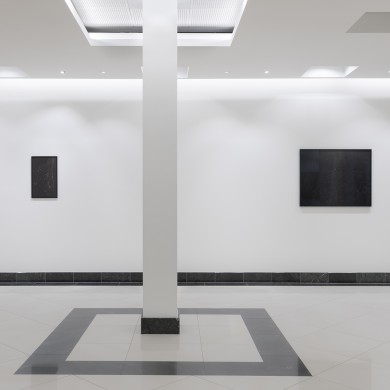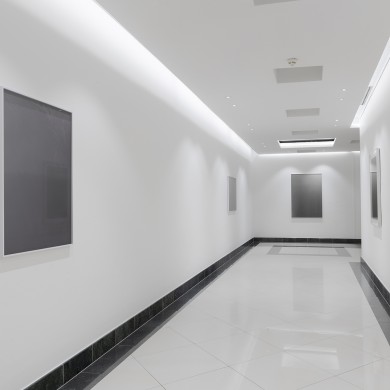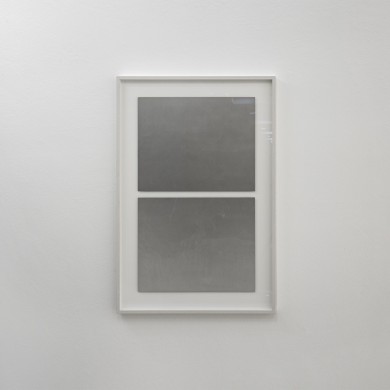Lucia Papčová | – scape
11 April – 7 June 2024
ZAHORIAN & VAN ESPEN, Carlton Savoy Bratislava
Lucia Papčová’s photographs demand attention. A long and concentrated gazing, where an eventual image surfaces from individual recognisable fragments. That remains always, as it were, intuited, without clear contours. Identification demands time and patience. Also inclining us to slow down is Lucia’s interest in contemplation, i.e. marking a space for observation.
With a concentrated gaze, ultimately we discern a landscape and its attributes. A snowfield on a rock wall, the shadow of a stony cliff, a spyhole into a cave. The theme, despite its deliberate obscuration (or more precisely hyper-clarification, excessive illumination of the image), is important. The author waits for the appropriate light, lets herself be dazzled, and the camera lens captures a clear shining. The photograph, presented in monochromatic colour, records a place; it is the bringing to presence of a moment that one had to wait for. It is an image for which one had to go wandering, and a proof of a luminous situation that will never again recur. Precisely this interest in what is fleeting, while recording apparently changeless landscape sections (mountain walls, forest, cave etc.) is a defamiliarisation of our mode of gazing. It is a prolongation of concentration to the extent where we begin to become aware of our own presence before the image. The object of observation returns us to the subjective experiencing of our own corporality.
When considering the landscape, the dimension of the picture also has its importance. The format of the photograph evokes an open window, through which we are looking at a landscape, and in viewing we become aware of its material aspect also. Sight slides over the surface, till at last the eye finds an identifying sign that can extract a definable form or phenomenon from the abstract structure.
Precisely composed landscapes appear in the photographic images. They confront us with time, testing our patience for recognition of what we see, and in yet another way besides. The landscape emerges on a plane of permanence, durability, as opposed to human transience. Its formation is a matter of inconceivable time, and its contemporary form is the result of diverse transformations. As the Slovak poet Ivan Laučík wrote: “Important in caves is the water that has flowed through them”. In Lucia’s photographs there are slices of landscape which essentially are what formed them. This result of a long-term “creation” is disturbed by an irruption of light, the photographic medium par excellence. The light does not reveal, but on the contrary, it dazzles, and thus the primary theme of the works becomes the one who is identifying: the subject. Human beings, that is to say, are equally the result of their formative processes and events. They are shaped by the thoughts and actions that have flowed through them./ Ján Kráľovič
Lucia Papčová | – scape
11.4. – 7.6.2024
ZAHORIAN & VAN ESPEN, Carlton Savoy Bratislava
Fotografie Lucie Papčovej si vyžadujú pozornosť. Dlhé sústredené dívanie sa pri ktorom sa z jednotlivých rozpoznateľných fragmentov pomaly vynára výsledný obraz. Ten ostáva vždy akoby tušený, bez jasných kontúr. Identifikácia vyžaduje čas a trpezlivosť. K týmto elementom spomalenia smeruje aj Luciin záujem o kontempláciu, t.j. vyznačenie priestoru na pozorovanie.
Pri sústredenom pohľade napokon rozoznávame krajinu, jej atribúty. Snehové pole na skalnej stene, tieň kamenného brala, priezor do jaskyne. Námet je napriek jeho zámernému znejasňovaniu (alebo presnejšie „pre-jasňovaniu“, presvetľovaniu obrazu) dôležitý. Autorka čaká na vhodné svetlo, nechá sa oslepovať a šošovka fotoaparátu zachytáva jasný svit. Fotografia, prezentovaná v monochromatickej farebnosti, zachytáva záznam miesta, ktorého presná lokalizácia snáď ani nie je dôležitá. Je sprítomnením momentu na ktorý bolo treba počkať. Je obrazom za ktorým bolo treba putovať a dôkazom svetelnej situácie, ktorá sa už nezopakuje. Práve tento záujem o prchavosť v zaznamenávaní zdanlivo nemenných krajinných častí (horské steny, les, jaskyňa apod.) je ozvláštňovaním nášho spôsobu dívania sa. Je predlžovaním koncentrácie do tej miery, že si začíname uvedomovať našu vlastnú prítomnosť pred obrazom. Objekt pozorovania nás navracia k subjektívnemu prežívaniu vlastnej telesnosti.
Čo je objektom Luciiných obrazov je ale dôležité. Na veľkoformátových fotografiách sa objavujú presne komponované krajiny, ktorá nás konfrontujú s časom ešte inak ako tým, že testujú našu trpezlivosť rozpoznávajúceho videnia. Krajina tu vystupuje v rovine stálosti, trvalosti oproti ľudskej pominuteľnosti. Jej formovanie a premeny sú záležitosťou nepredstaviteľného času a jej aktuálna podoba je výsledkom rozmanitých premien. Ako napísal slovenský básnik Ivan Laučík: „V jaskyniach je dôležitá voda ktorá nimi pretiekla“*. Na Luciiných fotografiách sú výrezy krajiny ktorých podstatou je to, čo ich formovalo. Tento výsledok dlhodobého „tvorenia“ je narušený vpádom momentu, svetlom ako fotografickým médiom par excellence. Svetlo tu nezjavuje, ale naopak; oslepuje a tak sa primárnou témou Luciiných diel stáva ten kto rozpoznáva: subjekt. Človek je totiž rovnako výsledkom procesov a udalostí, ktoré ho formovali. Je formovaný myšlienkami i skutkami ktoré ním pretiekli. / Ján Kráľovič
